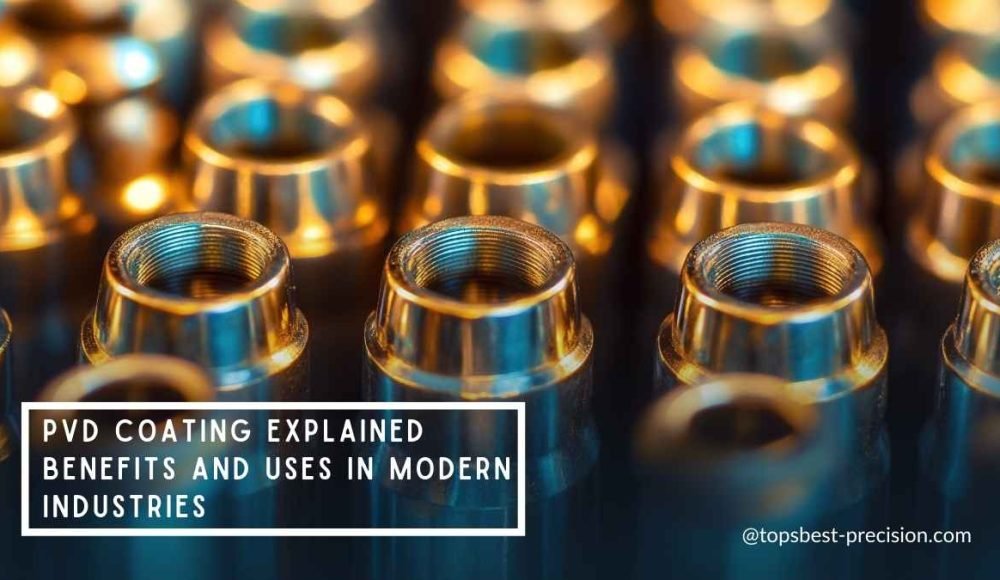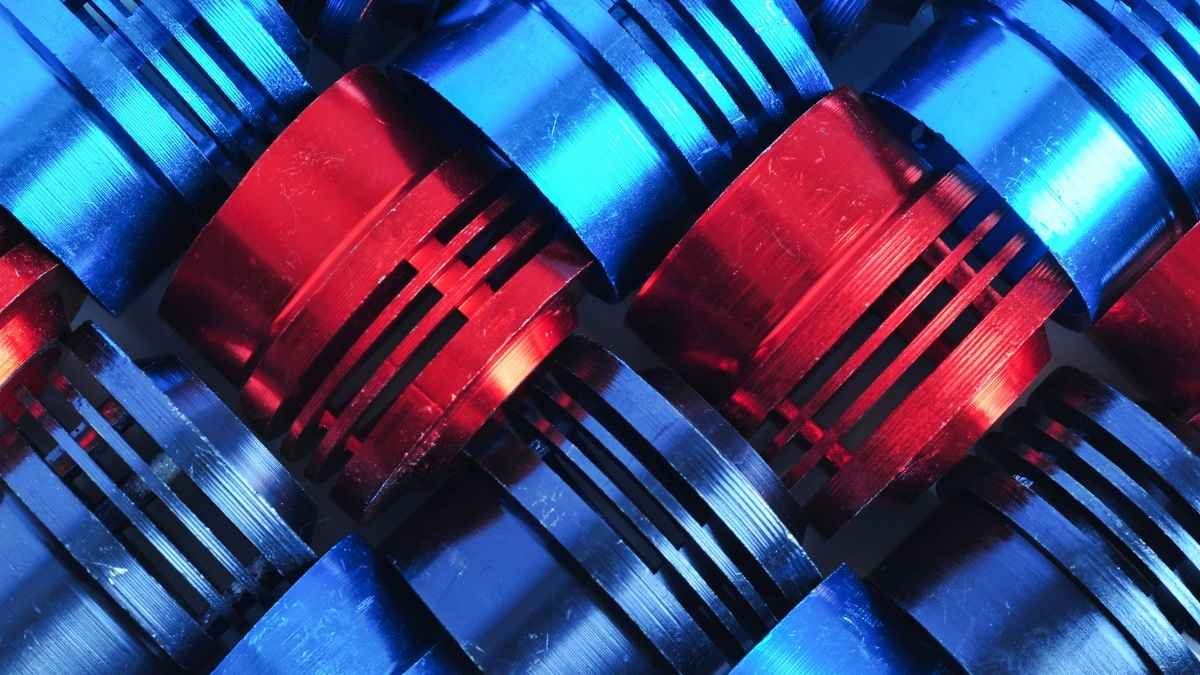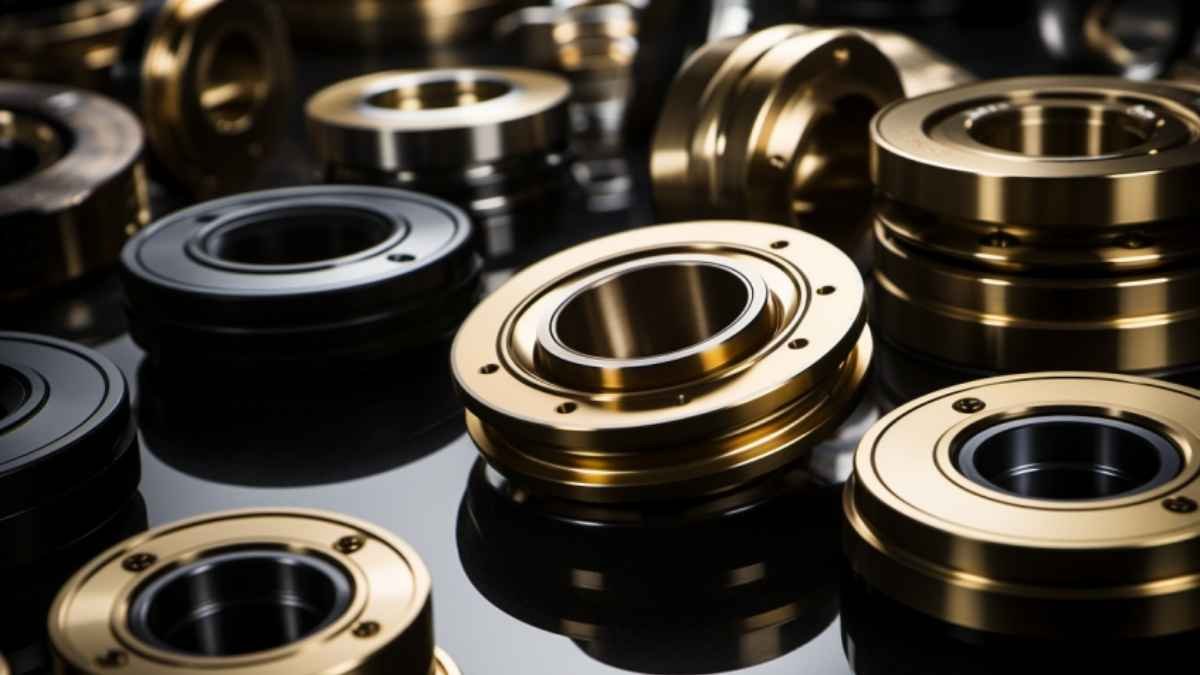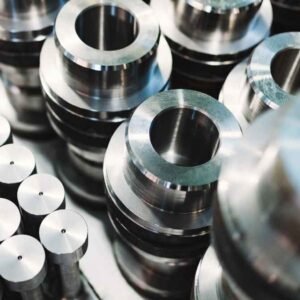طلاء PVD هي طريقة معالجة السطح الفائقة. يتضمن تطبيق أفلام رقيقة وصعبة على ركائز مختلفة من خلال عمليات مرحلة البخار. عمومًا, يساعد PVD في تحسين ميزات السطح مثل الصلابة, يرتدي, وتآكل السطح الذي يتم علاجه. يتم تطبيق الطلاء PVD في السيارات, الفضاء الجوي, والصناعات الطبية لوظيفة ومتانة العديد من المكونات. يتم إجراء العملية عادة في غرف الفراغ. فضلاً عن ذلك, يوفر تحكمًا دقيقًا في سماكة الطلاء وخصائص المواد, يمكن الحصول على نتائج عالية الجودة لتطبيقات محددة.
ما هو طلاء PVD? المبادئ الأساسية
طلاء PVD هو تقنية تشطيب حيث يتم تحويل المواد المكثفة في الطور الصلب إلى الطور الغازي. ثم يتكثف هذا الغاز على سطح المادة المستهدفة ويشكل ارتباطًا رفيعًا للمواد الصلبة. يحدث في غرفة فراغ للحفاظ على دقة ونقاء العملية.
يزيد هذا الطلاء من خصائص المواد على سطحها مثل الصلابة, تآكل, وارتداء المقاومة. كثيرا ما توظف المعدن, السيراميك, أو سبيكة كمواد طبقة المعطف. يحتوي طلاء PVD على العديد من الفوائد مثل التحمل العالي والأداء المرتفع. علاوة على ذلك, كما يسمح للشركة المصنعة بتصميم المعاطف اعتمادًا على الاحتياجات. يتم تطبيق مثل هذه الطلاء على نطاق واسع في أدوات درجات الحرارة العالية, مكونات السيارة, وتصنيع الأدوات الطبية.
عمليات PVD في الصناعة
تتضمن خطوات العملية المشاركة في عملية طلاء PVD:
1. اختيار المواد
أولاً, هناك خيار من المواد للطلاء. يتم اختيار المعادن والسبائك بناءً على خصائص المواد: يمكن أيضًا اختيار السيراميك في بعض الحالات. يفضل أن توفر هذه الخاصية الميزات المطلوبة مثل الصلابة, التآكل وكذلك الاستقرار الحراري.
2. تحضير السطح
قبل تطبيق الطلاء, يجب تحضير مادة الركيزة عن طريق التنظيف. يجب أن تضيق عملية التنظيف لإزالة الملوثات, زيت, وأكاسيد بحيث يمكن أن يلتزم السطح بإحكام. تشمل طرق إعداد السطح للترسب التنظيف بالموجات فوق الصوتية للعينة أو تنظيف البلازما.
3. إعداد غرفة فراغ
ثم يتم وضع المادة في غرفة فراغ حيث يتم تقليل ضغط الغاز عادة إلى نطاق منخفض. يجب ألا تكون الظروف البيئية مثل الفراغ ملوثة لضمان الدقة فيما يتعلق بالترسب. تكييف درجة الحرارة والضغط هو عندما يمكن إدخال درجة حرارة وضغط محددة فقط خلال العملية في الغرفة.
4. تبخير
في التبخير, تتعرض مادة الطلاء للحرارة ويتحول إلى شكل البخار/الغاز. عادة ما تستخدم هذه التقنيات مثل الضعف أو التبخر الحراري لتغيير المراحل. ثم, يتم نقل الأبخرة من خلال غرفة الفراغ إلى جانب الركيزة, للترسب.
5. ترسب
يتم ترسيب المادة طبقة حسب الطبقة وعندما تكون ساخنة, يتحول إلى غاز ويصلح طبقة رقيقة عندما يتم تبريده. بالمقارنة مع الطلاءات الأخرى المماثلة المناسبة للمواد المركبة, هذا الطلاء موحد نسبيًا بدون أية قفزة ولا توجد مساحة بين الركيزة وسطح الطلاء. يمكن التحكم في السمك المادي للمعطف والخصائص الكبيرة التي تصاحبها بمعدل الترسيب ودرجة الحرارة.
6. تبريد
العملية التالية بعد الترسب هي تبريد بطيء للمواد المغلفة الإجمالية. هذا يعني أن التحكم في عملية التبريد هذه يساعد في القضاء على قضايا مثل التكسير. بالإضافة إلى, يقلل من درجة حرارة الركيزة يعزز نظام الطلاء, ويجعل الفيلم الرقيق المودع قوي.
7. فحص الجودة
أخيرًا, تخضع المادة المطلية للتدقيق الشديد والفحص اليدوي. يقوم المصنعون بتقييم سمك الطلاء, التوحيد, ومناطق الالتصاق بشكل متكرر. طرق متطورة مثل مسح المجهر الإلكتروني/SEM, انتقال الإلكترون المجهر/TEM, أو يتم استخدام تحليل حيود الأشعة السينية لتقييم جودة الطلاء وضمان جودة مناسبة للطلاء النهائي وفقًا لمواصفات الصناعة.
مزايا الطلاء PVD
فيما يلي الفوائد الفريدة لطلاء PVD:
1. تحسين مقاومة التآكل
تحسن طلاء PVD مقاومة التآكل من خلال إيداع طبقة سطحية صلبة وقوية. بسبب الطبقات الرقيقة المودعة التي تم إنشاؤها أثناء عملية PVD, من الممكن تقليل الاحتكاك وحماية سطح العمل. خصوصاً, إنه مفيد تمامًا في أسواق مثل الفضاء أو السيارات لأن مكونات المعدات ذات الصلة تخضع للبلى. فضلاً عن ذلك, إنه يجعل الأجزاء لها حياة أطول وتؤدي بشكل ممتاز في ظل ظروف حيث تتحلل الأجزاء العادية.
2. المقاومة للتآكل
يثبت الطلاء PVD أنه الأفضل عندما يتعلق الأمر بحماية السطح من التآكل. يوفر الفيلم المستمر الرقيق للمواد طبقة حاجزًا يحمي مواد الركيزة من الرطوبة, مواد كيميائية, والملح. خصوصًا, إنه مفيد للأجزاء التي يتم إنتاجها عادةً للاستخدام في الظروف القاسية بما في ذلك السيارات والصناعات. لأن, من المحتمل أن تتعرض أجزاء من الجهاز لظروف التآكل, ويجب أن يعمل الجهاز لفترات طويلة.
3. جماليات الأجزاء
بالإضافة إلى مزايا الأداء, تدل الطلاء PVD على جماليات المنتج النهائي. تأتي الطلاء PVD في مجموعة واسعة من الألوان, تشطيب السطح, والقوام لإعطاء مظهر فاخر. إنه مفيد بشكل خاص في المنتجات الاستهلاكية المتينة مثل الإلكترونيات, مجوهرات, وقطع الغيار والملحقات التلقائية. هكذا, يصبح من الأسهل على الشركات المصنعة إضافة قيمة إلى أسطح منتجاتها لإنتاج منتجات مذهلة مع الحفاظ عليها مفيدة وطويلة الأمد, معًا.
4. الفوائد البيئية
تعتبر الطلاء PVD مقاربة أكثر ملاءمة للطلاء من الأنظمة التقليدية. أداء PVD متفوق على العمليات الكيميائية, التي تستخدم المذيبات السامة, وإنتاج بقايا خطرة, كما يتضمن PVD ترسب البخار المادي. العملية أكثر أمانًا, بسبب عدم وجود استخدام كيميائي خطير ويتوافق مع معايير صارمة للظروف البيئية. PVD يساعد في جعل ممارسات التصنيع المستدامة. لذلك, الشركات التي تتبنى ممارسات PVD صديقة للبيئة.
5. التخصيص والدقة
يتيح لك طلاء PVD تحديد خصائص محددة. يمكن أن تختلف عدة سمات للبوليمر بما في ذلك سمك, صلابة المواد, واللون. علاوة على ذلك, إنه يتيح تحقيق أفضل مستويات الأداء والمتانة, وبالتالي زيادة جودة المنتج النهائي. من الأدوات إلى السيارات إلى المعدات الطبية, توفر الطلاء PVD حلولًا مخصصة وفعالة.
الصناعات التي تستفيد من عملية طلاء PVD
دعونا نلقي نظرة على الصناعات التحويلية التي تستفيد من عملية طلاء PVD:
1. صناعة السيارات
تعمل الطلاء PVD على تحسين متانة المنتج وحماية مكونات المحرك, تعظيم عمر الجزء. تنطوي منصات الفرامل المغلفة على PVD بتحسين معامل الاحتكاك. لأجزاء الإرسال, وتشمل الفوائد انخفاض التآكل والتعب, جنبا إلى جنب مع مقاومة التآكل. يتلقى القطع الخارجية التلقائية طلاءًا أنيقًا بالإضافة إلى طلاء صعب من خلال PVD. العجلات المغلفة PVD لا تخدش بسهولة وتوفر الانتهاء من اللمعان العالي. فضلاً عن ذلك, تحسن طلاء PVD من قوة المواد التي تشكل أنظمة الوقود بما في ذلك حقن الوقود.
2. صناعة الطيران
في تطبيقات الفضاء, لا تخضع شفرات التوربينات المطلية بـ PVD لارتداء درجات الحرارة العالية. تبرر الطلاء PVD تطبيقها على معدات الهبوط من خلال تحسين مقاومة التعب للمنتج. المحامل والأختام أيضا يتم حماية من الاحتكاك والتآكل. تقوم الطلاء PVD بتخفيف الاقتصاد في استهلاك الوقود عن طريق التقليل إلى الحد الأدنى من فرك في المحركات. الأجزاء المغلفة بالفضاء PVD والتي عادة ما تتعرض للتجوية تظل أيضًا صعبة وغير مقلوبة.
3. الصناعة الطبية
لا تتآكل الأدوات المغلفة PVD المستخدمة في الإجراءات الطبية وارتداءها لأن PVD بمثابة حاجز فعال. تشمل عمليات زراعة العظام توافقًا حيويًا أعلى. لا تتسبب الطلاء PVD أيضًا في عدم وجود تأثير تدهور على الأجهزة الطبية المستخدمة في سوائل الجسم. علاوة على ذلك, أدوات وزراعة الأسنان تبقى أطول ولديها فرصة أقل للتلوث. فضلاً عن ذلك, تحسن الطلاء PVD من عمر أجزاء من أجهزة القلب والأدوات المستخدمة في العمليات الجراحية.
4. صناعة الإلكترونيات
في أغلفة الهواتف الذكية, PVD يجعل السطح غير مخدش بسهولة وله نظرة جيدة. يتم تحقيق أداء أعلى للموصلات والمفاتيح من خلال تطبيق الطلاء PVD. PVD يحسن موثوقية المكونات الإلكترونية المتآكلة للملابس الميكانيكية. الطلاءات المضادة ومكافحة الخدش تحمي شاشة الهواتف المحمولة. بالإضافة إلى, يضيف PVD أيضًا جماليات الأجهزة القابلة للارتداء والأجهزة الإلكترونية الأخرى.
5. أداة وصناعة التصنيع
يوفر PVD تحسين صلابة وارتداء أدوات القطع. توظف التصنيع قوالب ويموت لا تلبس بسبب الطلاء PVD. في عمليات الحرارة, يعد الاستقرار على مستوى درجات الحرارة العالية ميزة للأدوات ذات الصلة. تستخدم أدوات الحفر وأدوات CNC تآكل أقل أثناء تشغيل الآلات الدقيقة. بالمقارنة مع PVD, تتمتع قوالب الحقن بعمر خدمة أطول في حالة استخدام PVD, وبالتالي زيادة معدلات الإنتاج.
6. مجوهرات & صناعة السلع الفاخرة
تقدم الطلاء PVD بريقًا, والطلاء المضاد للخلع للمجوهرات. ميزة شراء الساعات والملحقات الفاخرة تحتفظ بصعوبة, نظرة رائعة من خلال PVD. يضيف التحف أو اللمعان التمييز إلى العناصر الفاخرة; المنتجات الفاخرة تأتي في تشطيبات مختلفة. الخواتم والأساور مع الطلاء PVD أقل تهالكا وتلاشى. لا يحتاج استخدام المنتجات الفاخرة إلى إعادة الطلاء بشكل متكرر لأن لديهم مظهر جيد لفترة أطول.
7. الطاقة وتوليد الطاقة
يتم حماية أجزاء محطة توليد الطاقة من التآكل وارتداءها بواسطة الطلاء PVD. تميل أجزاء كثيرة من توربينات الرياح إذا كانت مطلية بـ PVD تميل إلى الحصول على مدة خدمة أطول خاصة عندما تكون القوى البيئية في اللعب. تتميز الموصلات المستخدمة في الألواح الشمسية بالتآكل والنتائج لتحسين الطاقة. تتمتع شفرات التوربينات الغازية المغطاة بـ PVD بميزات ذات درجة حرارة عالية ومقاومة للأكسدة.
تلخيص
الطلاء PVD إعطاء مزايا هائلة عبر الصناعات, والعديد من الشركات تطلب جماليات المنتج على نطاق واسع. في السيارات, أنها تعمل على تحسين مقاومة التآكل والمظهر. المجالات الرئيسية للتحسين هي تحسين المتانة والحماية من التآكل الذي يؤثر على مكونات الفضاء. في المنطقة الطبية, إنه يعزز دورة الحياة وأداء عمليات الزرع وأدوات الجراحة. نفذت صناعة الإلكترونيات PVD لتحسين المتانة ومظهر السطح الأملس.
في الأدوات والتصنيع, طلاء PVD تقلل من التآكل من أدوات القطع والعفن. تحتاج صناعة المجوهرات إلى الطلاء المقاوم, وعندما تكون هذه طويلة الأمد, ومقاوم الخدش مكافأة. في توليد الطاقة وتوليد الطاقة, على سبيل المثال, PVD يمنع تكوين التآكل والتآكل على الأجزاء والمكونات. أخيراً, في التطبيقات الدفاعية والعيدة ، ضمان الطلاء VD أن المعدات محمية بشكل صحيح وستعمل بشكل فعال في البيئات القاسية.







1 فكرت في "شرح طلاء PVD: الفوائد والاستخدامات في الصناعات الحديثة”